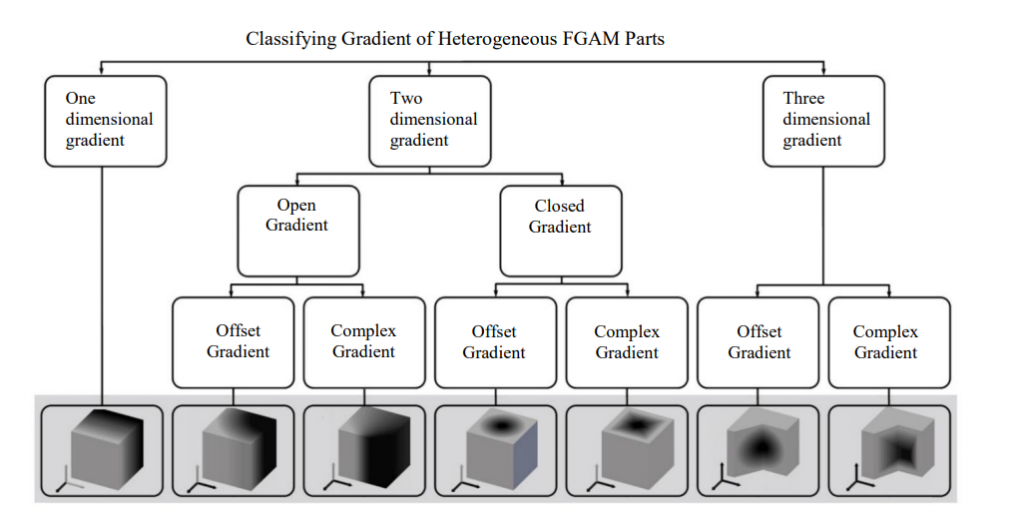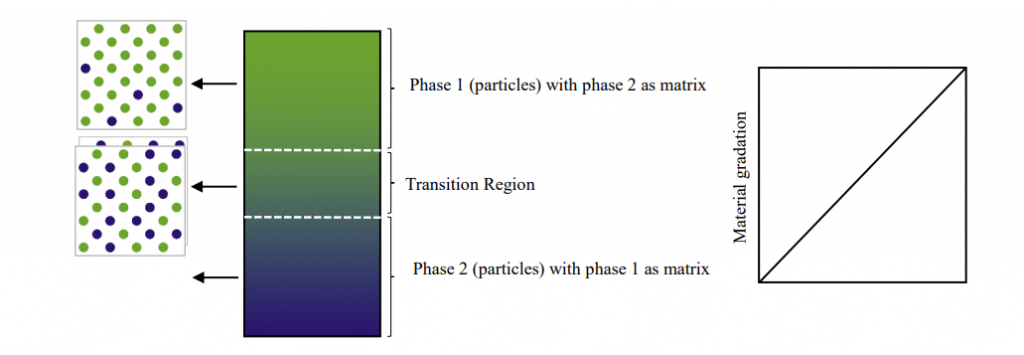G.H. Loh and E. Pei explore the benefits of functionally graded additive manufacturing in ‘Building a conceptual understanding of Functionally Graded Additive Manufacturing (FGAM) and its limitations,’ exploring further 3D printing processes in terms of hardware, software, and the ever-expanding science of materials. With FGAM, researchers are employing a new method that creates a variety of gradients within the printed material depending on requirements for a prototype or part. Here, the authors also explore limitations of FGAM currently, and ways to surpass them.
Developed in the 80s for an aerospace thermal resistance project, functionally graded materials are both advanced and offer a spatially varying makeup—allowing for changes in material properties.
With the inception of more mainstream AM processes, it quickly became clear that such technology would be a logical choice for the creation of FGM parts via FGAM—holding promise for structures that could be heavily customized and more efficiently engineered. A strengthened material matrix can be ‘precisely controlled’ in terms of:
- Amount
- Volume
- Shape
- Location
“By simplifying the assembly of complex part using dynamic gradients, some disadvantages of traditional composites can be avoided such as reduced in-plane and transverse stresses at critical locations and improving the distribution of residual stress,” explain the researchers.
Less support material is needed also as FGAM parts will self-stabilize in the process of creating ‘performance-based freeform components.’ The materials are transformed due to variations in composition, which can be defined as any of these three types:
- Variable densification within a homogeneous composition – this can be changed through property and functional deviations.
- Heterogeneous composition through simultaneously combining two or more materials through gradual transition – FGAM tends to refine the bonding between materials by eliminating boundaries between dissimilar or incompatible matter. Mechanical and thermal stress can be reduced also.
- Combination of variable densification within a heterogeneous composition – gradients optimize combination of component properties like weight, strength, wear and impact resistance, toughness, and more—and can also transform mechanical properties.
Overall, FGAM can expand on the benefits of 3D printing and additive manufacturing in prototyping especially, as well as combining functions into one manufacturing step without extra cost; however, education regarding FGAM and understanding the materials and necessary parameters can be complicated.
“It is a technical challenge to determine the overall component geometry and to regulate the optimal spatial distribution and the transition between the heterogeneous materials,” conclude the researchers, stating the need for databases regarding characteristics and predictive models.
“Criteria must be established to choose the best strategies in material characterization, defining the optimum material distribution and exploration on the methodology to measure the material properties of manufactured components,” conclude the researchers. “In parallel, future work needs to emphasis on software engineering of 3D forms incorporating material properties and behaviour with potentially real-time fabrication feedback. The range of expression and applications will simultaneously increase as the processing technology, cost of production and properties of FGM improve.”
The study of materials for 3D printing and additive manufacturing continues to grow, from use with techniques like FGAM, to using graded materials with an extrusion screw, creating soft mechanical materials for robotics, printing self-healing capsules for concrete, and more. What do you think of this news? Let us know your thoughts! Join the discussion of this and other 3D printing topics at 3DPrintBoard.com.
[Source / Images: ‘Building a conceptual understanding of Functionally Graded Additive Manufacturing (FGAM) and its limitations’]Subscribe to Our Email Newsletter
Stay up-to-date on all the latest news from the 3D printing industry and receive information and offers from third party vendors.
You May Also Like
3D Printing News Briefs, April 13, 2024: Robotics, Orthotics, & Hypersonics
In 3D Printing News Briefs today, we’re focusing first on robotics, as Carnegie Mellon University’s new Robotics Innovation Center will house several community outreach programs, and Ugogo3D is now working...
Rail Giant Alstom Saves $15M with 3D Printing Automation Software 3D Spark
3D Spark has entered into a three-year deal with the rail giant Alstom. Alstom, a transport behemoth with annual revenues of $16 billion, specializes in the manufacture of trains, trams,...
Meltio Expands Global Reach with New Partnerships in the Americas and Europe
Spanish 3D printing manufacturer Meltio has expanded its sales network across the globe. With the addition of three new partners in the United States, Brazil, Argentina, and Italy, Meltio aims...
3D Printing Webinar and Event Roundup: April 7, 2024
Webinars and events in the 3D printing industry are picking back up this week! Sea-Air-Space is coming to Maryland, and SAE International is sponsoring a 3D Systems webinar about 3D...



































